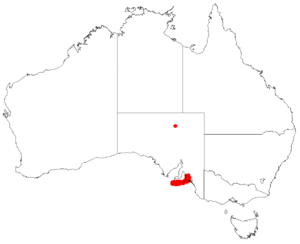Small bull oak facts for kids
Quick facts for kids Small bull oak |
|
|---|---|
| Scientific classification | |
| Genus: |
Allocasuarina
|
| Species: |
striata
|
 |
|
| Where this plant grows in Australia | |
The Allocasuarina striata, also known as the small bull oak, stalked oak-bush, or tall oak-bush, is a type of shrub. It belongs to the Allocasuarina family and naturally grows in South Australia. This plant is known for its unique look and useful features.
Contents
What Does the Small Bull Oak Look Like?
This shrub or small tree usually grows to be about 1.5 to 2.5 meters (5 to 8 feet) tall. Some can even reach up to 4 meters (13 feet) high. It typically spreads out about 1 to 1.5 meters (3 to 5 feet) wide.
The plant has a thick, upright, and rounded shape. Its bark is smooth when young, but it gets cracks as the tree gets older.
Leaves and Flowers
The small bull oak has special stem segments that are smooth and grooved. These segments can be up to 2 centimeters (0.8 inches) long. Around the end of each segment, there are seven tiny, reduced leaves.
This plant can have separate male and female plants (dioecious) or both male and female flowers on the same plant (monoecious).
- Male flowers: These grow in slender spikes up to 3 centimeters (1.2 inches) long. They have 5 to 7 rings of flowers per centimeter.
- Female flowers: These are yellow-brown and about 1.3 millimeters (0.05 inches) long.
Fruits and Seeds
After flowering, the plant produces small, woody, cylinder-shaped cones. These cones have many small openings called valves. Inside, you'll find smooth, somewhat flat, black seeds. Each seed has a papery wing, which helps it fly away in the wind.
Where Does the Small Bull Oak Grow?
The small bull oak is found only in South Australia. It grows in the southeastern part of the state. You can find it in the southern Mount Lofty Ranges, on the Fleurieu Peninsula, and on Kangaroo Island.
It prefers to grow in sandy soils that contain laterite, often in areas with heathland. When people plant it in gardens, it grows best in full sun or partial shade. It is often found on hills, at the bottom of slopes, and on flat plains. This tough plant can handle dry weather, some frost, and even salty soil.
How People Use the Small Bull Oak
The small bull oak is a strong and useful plant.
- Gardening: It is often planted as a low, informal hedge along roadsides or in raised garden beds.
- Parks and Reserves: It helps hold soil in place, which is important for preventing erosion. It also provides a safe home and food for birds and small animals. Its dense growth makes it a good windbreak.
- Traditional Uses: Aboriginal peoples used this plant in many ways.
- They used parts of the plant for food and medicine.
- They made tools like boomerangs and shields from its wood.
- They also used it to make sticky substances to seal canoes.
How the Small Bull Oak Was Named
The small bull oak was first officially described in 1927. A botanist named Ellen D. Macklin gave it the scientific name Casuarina striata.
Later, in 1982, another botanist named Lawrence Alexander Sidney Johnson reclassified it. He moved it into the Allocasuarina group. This change was published in an article called Notes on Casuarinaceae II in the Journal of the Adelaide Botanic Gardens.
Images for kids


